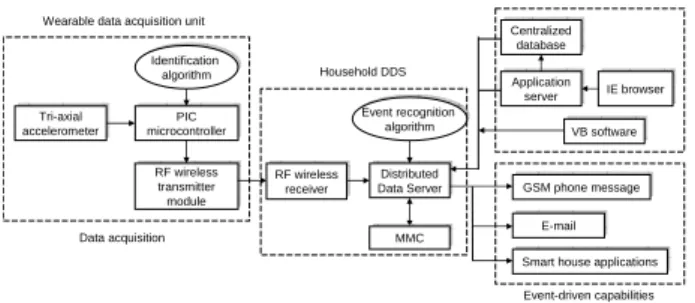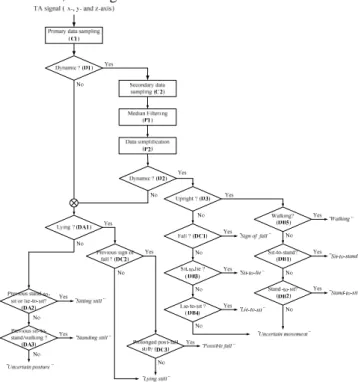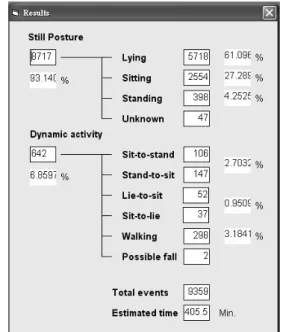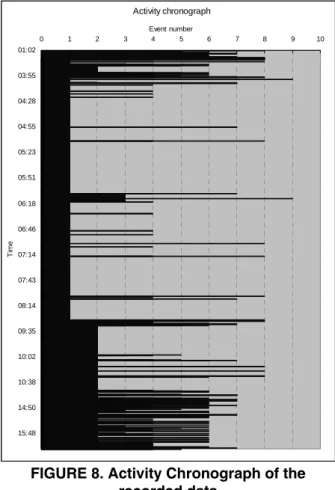Development of a Portable System for Physical Activity Assessment in a Home Environment
全文
(2) embedded in the microcontroller in that device is developed to actively recognize three still postures (sitting, standing, and lying), four postural transitions (sit-stand transitions and lie-sit transitions) and locomotion (walking) in a home environment. This system also features the fall detection capability to recognize any possible fall event. Long-term monitoring in a subject’s residence was also demonstrated to register the majority of daily activities.. (a) (b) Fig. 2. The wearable DAU (a) and household DDS (b). 2: METHOD AND SYSTEM DESIGN 2.1: INSTRUMENTATION Fig. 1 shows the structure of the system. A wearable data acquisition unit (DAU) primarily consisting of a miniature tri-axial accelerometer (KXM52-1050, Kionix, Inc.), a PIC microcontroller (PIC18F6722, Microchip) and a RF wireless transmitter module (PT2262, Princeton Tech.; TWS-CS-2, Wenshing Electronics Co., LTD) is designed for acceleration measurement and real-time identification of human postures and movements (Fig.2(a)). As shown in Fig 3, the DAU is designed to be carried at the waist level nearby close to the center of gravity of the body by means of clips onto the pant belt for easier and convenient use. From the empirical trial, the suitable position which lies within the range of 45 degrees from the frontal (antero-posterior) side to either of medio-lateral sides is consistent with the statement in the related studies [10],[12],[14]-[18]. This low-g (±2g) DC-responsive tri-axial accelerometer measures the acceleration produced by human movement as well as the constant gravity component. The accelerometer outputs are low-pass filtered at fc=50Hz and continuously sampled at 60Hz via 10-bit A/D conversion of the PIC microcontroller. Computation of a simple kinematic model is used to remove such a gravitational component instead of using physical high-pass filters. Each real-time identified activity event is transmitted cyclically via the 433.92MHz RF wireless transmitter module then to the distributed data server (household DDS) which features the capabilities of signal computing, I/O control, Ethernet communication, wireless RF data reception, data storage (MMC) and the links with external devices. Fig. 2(b) shows the household DDS. Data request Wearable data acquisition unit Identification Identification algorithm algorithm Tri-axial Tri-axial accelerometer accelerometer. Centralized Centralized database database Household DDS. RFwireless wireless RF transmitter transmitter module module Data acquisition. Application Application server server. Event recognition recognition Event algorithm algorithm. PIC PIC microcontroller microcontroller RFwireless wireless RF receiver receiver. Distributed Distributed Data Server Server Data. MMC MMC. IE browser browser IE. VB software software VB. GSMphone phone message message GSM E-mail E-mail Smart house houseapplications applications Smart Event-driven capabilities. Fig. 1. System structure. Fig. 3. The attachment of the wearable DAU. 2.2: ALGORITHM DESIGN A dedicated algorithm embedded in the microcontroller of the DAU is developed to identify three postures (lying still, sitting still, and standing still), four postural transitions (sit-stand, stand-to-sit, sit-to-lie and lie-to-sit) and walking movement. Detection for possible falls is also designed in this algorithm. Fig. 4 describes the process flow of the algorithm which mainly includes five parts: data sampling (Cx), pre-processing (Px), dynamic posture transition identification (DBx), still posture identification (DAx) and possible fall detection (DCx). All signals are processed in time-domain analysis in the algorithm due to the limited computation capability of the PIC microcontroller as well as the fact that batch data analysis in frequency-domain method yields inaccurate results. All the identified results are stored in the variable STATE. In the case where there is no definite result determined throughout the processes, the event will be recorded as an “Uncertain movement” or an “Uncertain posture”. The data sampling process consists of the primary stage (C1) and the secondary stage (C2) in 0.5s and 2.0s, respectively. The use of the dual-stage data sampling strategy ensures that the data of one event can be acquired within the same sampling interval. Initially, Sections C1 and D1 determine whether any sign of dynamic movement exists. If no dynamic movement be detected (D1=No), the sampled 0.5s data is used to identify one of the three possible still postures in the processes DAx. If dynamic movement is detected (D1=Yes), the secondary data sampling stage (C2) is immediately activated to collect the subsequent 2.0s data. The 2.5s data collected in both stages is combined and then median-filtered (window length n=3) and simplified (reduced to one-third of the original data amount by averaging method) to represent an “event” for the following step-by-step movement identification. - 1340 -.
(3) which is to identify either one of the four postural transitions, walking or a fall event.. Fig. 4. The flowchart of the algorithm The “slope mapping” technique which registers whether there are apparent fluctuations or changes in the data series is commonly applied in computation of the trunk tile angles and the tri-axial acceleration data in the algorithm. Various thresholds are given in most of the computation sections to yield the results of specific determination. Fig. 5 shows an example of a binary series (0 or 1 expressed as the bar chart) which registers the apparent changes of a trunk tilt data series (degrees in the form of curve) during a sit-to-stand postural transition mapped by this technique.. Fig. 5. Example of the effect of slope mapping technique In order to investigate the accelerometric characteristics of sit-stand transitions, a test was performed on 15 ostensibly healthy subjects in various ages arranged into three groups: Young (20-35yrs), middle-aged (35-50yrs) and elderly (50+yrs), with 5 subjects in each group. From the observation of the test, the vertical acceleration pattern of sit-stand postural transitions can be characterized by three particular rules: (i) peak order, (ii) peak distance (time interval) and (iii). peak values. Either of sit-stand postural transitions can only be identified when the criterion of all the three rules are satisfied. The lie-sit postural transitions can be identified and further distinguished from each other by investigating both the trunk tilt variation and the final posture orientation. Still posture identification requires the information of previously known postural transitions or walking movement. A still posture can be recognized as a lying still posture according to the posture orientation or if there exists a previous sit-to-lie postural transition. Similarly, sitting still or standing still postures can be identified by the existence of the types of previous sit-stand transitions or walking movement. In order to evaluate the performance of the algorithm in still posture and dynamic activity identification, 10 subjects were recruited for the laboratory-based test. Sensitivity and specificity tests for posture (lying still) and posture transitions (sit-stand transitions, lie-sit transitions) and walking movement were conducted. Note that the evaluation did not include the sitting still or standing still postures due to the fact that both still postures are associated with the results of previously identified postural transitions or movement. In addition, Falling was not included either because it was not easy for the testers to simulate “standardized” falls. Table 1 shows the evaluation results of sensitivity and specificity from 200 and 500 samples, respectively. TABLE 1. Performance of the algorithm Posture/activity Sensitivity (%) Specificity (%) Lying still 100 * Sit-to-stand 92.2 91.5 stand-to-sit 95.6 88.5 Sit-to-lie 92.2 99.5 Lie-to-sit 95.6 88.0 Walking 98.9 99.5 Fall detection in daily physical activity is important in the elderly care and rehabilitation. Intuitively, a fall can be regarded as a movement accompanying by unusual high acceleration peaks in a very short time interval. The measures of summation of time integrals of the accelerometer outputs (IMA) or signal magnitude vector (SVM) were proposed to evaluate the intensity of the physical activities [12],[14]. According to the definition given by Karantonis et al., falls are said to have occurred if at least two consecutive peaks in the SVM above a defined threshold 1.8g are recorded and followed by a 60s post-fall period of no activity [14]. As for the algorithm in this system, a “sign of fall” can be identified for a non-upright posture if there are at lest two peaks at relatively higher magnitude of ± 1.0g either in vertical or antero-posterior acceleration component. A “possible fall” event can be further identified from a previously registered “sign-of-fall” event followed by a 20s period of lying still posture without any activity.. - 1341 -.
(4) 3: SYSTEM INTEGRATION AND TEST With the Ethernet communication capability of the household DDS, it is accessible via the Internet. The monitoring of real-time activity status and the accumulation sum of each monitored item can be displayed by using the Internet browser on the client PC. This interface provides brief information of real-time acquired event data for the users without any dedicated software. Complete data management can be achieved by using dedicated PC-based VB-developed programs as Fig. 6 which features the following fundamental functions: (i). Remote data access capability: The authorized users (e.g., the system administrator, care-giver or families) are allowed to access to the DDS and retrieve the data stored in it through TCP communication. (ii). Real-time monitoring information: The real-time monitoring information (still posture or dynamic activity) is displayed on this interface. (iii). Recorded data display: The daily recorded data can be chronologically displayed to show the overall activity distribution. As shown in the Fig. 7 rests and activities can be distinguished. They are also classified and given quantitative results, such as the numbers, percentages of those events in the data. All the related information can be saved to an Excel file (*.xls). (iv). Event-driven function: The DDS can be optionally equipped with a GSM module to provide event-driven capability. When this function is enabled by the user, the DDS is able to actively send a cell phone text message to a user-specified person when a possible fall has been detected.. Fig. 7. Display of the statistical results of retrieved data Fig. 7 also shows an example of a subject’s long-term monitoring data in a day at home. In this test, the system began to record data at about 1:00 and ended at about 16:00. In the home environment, the user (subject) is not expected to use this system continuously throughout the monitoring period during some situations such as taking a shower, going outside, etc. Therefore, the data recorded may not be continuous, and the actual monitoring time in this test is about 405 minutes. That is, about 6.75 hours within the 15-hour period is recorded. According to the statistical results shown in Fig. 7, more than 90% of the recorded events are still postures. Moreover, lying still postures occupy about 61% of total recorded events. Figure 8 is the activity chronograph which chronologically displays the recorded events represented as a series of event number 1 to 9. It can be observed that the subject was mostly in the “lying still” (event number 1) posture from 4:00 to 9:00, which indicates that the subject was probably sleeping during that period. In addition, the subject had large numbers of “sitting still” (event number 2) postures from about 9:00 to 13:00. After 14:00, the subject performed many posture transitions and walking movements (event number 4 to 8).. Fig. 6. VB-developed program interface. - 1342 -.
(5) To extend the time for use, a battery cartridge with (3×AA alkaline batteries) can be used instead of the AAA batteries. The antenna configuration also has a great influence on the performance of wireless data delivery. However, the antenna design has not been further evaluated. In the future, the onboard antenna and optimization must be taken into consideration. The limitation in computation capability and memory capacity of the microcontroller used in this study, coupled with the fact that human events must be identified simultaneously to keep up with the next data acquisition process, limit the identification performance. Most other off-line systems use powerful PC-based computation software such as MATLAB to analyze the recorded data. Therefore, identification accuracy of those systems is usually higher than that of the real-time systems [13]. Moreover, the durations of posture transitions or movement are not the same each time, even for the same person. People usually perform mixed and combined movements in their normal activities of living. Due to the complex nature of human movement and limitations in instrumentation, identification accuracy for such a real-time system can be limited when applied in real ambulatory and home uses, despite that fact that it achieves good performance for laboratory-set tests.. Activity chronograph 0. 1. 2. 3. Event number 4 5. 6. 7. 8. 9. 10. 01:02. 03:55. 04:28. 04:55. 05:23. 05:51. 06:18. Time. 06:46. 07:14. 07:43. 08:14. 09:35. 10:02. 10:38. 14:50. 15:48. FIGURE 8. Activity Chronograph of the recorded data. 5: CONCLUSSION. 4: DISCUSSION The physical activity assessment system which utilizes only one wearable sensing device has been developed and demonstrated in ambulatory tests. This system also achieves good performance in still posture and dynamic activity identification. However, some inherent limitations are worth discussing here. An advanced capacitance tri-axial accelerometer was used in this study to measure the acceleration and trunk tilt of the human body. In fact, the most precise tilt sensing can be maintained when the accelerometer is at static, or under constant acceleration. Tilt sensing using accelerometers still has limited accuracy of tilt sensing in changing acceleration magnitude. It was also reported by Elber’s research on gravitational artifact in accelerometric measurement [19]. However, In spite of this constraint, tilt sensing and acceleration measurement using one tri-axial accelerometer is still valid for physical activity because the resulting outputs still preserve apparent characteristics for either trunk tilt and acceleration patterns. The wearable DAU has been designed to measure human body movement at waist level and clipped to the belt for minimizing discomfort and inconvenience in use. However, carrying the DAU might limit posture and movement when lying down and therefore further influences the subject’s comfort. As for wireless data transmission, power capacity has a significant influence on the effective distance and stability of data delivery.. In this study, a real-time system for human physical activity assessment using only one portable sensing device was developed for real-time ambulatory monitoring in a home environment. This system is able to distinguish rests from activities and further identify several target posture transitions and movements. Although the nature of actual human postures and activities of daily living are more complex than what is considered and assumed in the algorithm, this algorithm still exhibits acceptable performance in determining those target postures and activities. Despite some limitations in the configuration for real-time data processing, this system is technically viable to perform long-term ambulatory monitoring in a home environment and to provide sufficient information in evaluating a person’s activities of daily living (ADLs) and his status of physical mobility. The results from the ambulatory tests also show that this system can provide significant information on the subject’s activities of daily living. In the future, the application field of this system, system robustness and reliability and the possibility for ubiquitous computing which integrates all the ADL-related data altogether should be further considered.. - 1343 -.
(6) REFERENCES [1]. Capspersen, C. J., Powell, K. E., Christenson, G. M., 1985. “Physical activity, exercise and physical fitness: Definitions and distinctions for health related research,” Public Health Rep., vol. 110, pp. 126-131. [2]. Foerster, F., Smeja, M., and Fahrenberg, J., 1999. “Detection of posture and motion by accelerometry: A validation study in ambulatory monitoring,” Comput. Hum. Beh., vol. 15, pp. 571-589. [3]. Aminian, K., Najafi, B., 2004. “Capturing human motion using body-fixed sensors: outdoor measurement and clinical applications,” Comp. Anim. Virtual Worlds, pp. 79-94, John Wiley & Sons. [4]. Kemp, B., Janssen, A., Kamp. B. V. D., 1998. “Body position can be monitored in 3D using miniature accelerometers and earth-magnetic field sensors,” Electroencephalography and clinical Neurophysiology, vol. 109, pp. 484-488. [5]. Dickstein, R., Abulaffio, N., Gelernter, I., Pillar, T., 1996. “An ultrasonic-operated kinematic measurement system for assessment of stance balance in the clinic,” Clinical Biomechanics, vol. 11, pp. 173-175. [6]. Saris, W. H. M. and Binkhorst, R. A., 1977. “The use of pedometer and actometer in studying daily physical activity in man. Part I: reliability of pedometer and actometer,” Eur. J. Appl. Physiol., vol. 37, pp. 219-228. [7]. Saris, W. H. M., Binkhorst, R. A., 1977. “The use of pedometer and actometer in studying daily physical activity in man. Part II: validity measuring the daily physical activity,” Eur. J. Appl. Physiol., vol. 37, pp. 229-235. [8]. Verschuur, R., Kemper, H. C. G., 1980. “Adjustment of pedometers to make them more valid in assessing running,” Int. J. Sports. Med., vol. 1, pp. 95-97. [9]. Moris, J. R., 1973. “Accelerometry-a technique for the measurement of human body movements,” J. Biomech., vol. 6, pp. 729-736. [10]. Gerwin A. L. Meijer, Klaas R. Westerterp, Francois M. H. Verhoeven, Hans B. M. Koper, and Foppe ten Hoor, 1991, “Methods to Assess Physical Activity with Special Reference to Motion Sensors and Accelerometers,” IEEE Trans. On Biomed. Eng., vol. 38, No. 3, pp. 221-229.. [11]. Veltink, P. H., Bussmann, H. B. J., Vries, W. D., Martens, W. L. J., Lummel, R. C. V., 1996. “Detection of static and dynamic activities using uniaxial accelerometers,” IEEE Trans. Rehab. Eng., vol. 4, pp. 375-385 [12]. Bouten, C. V. C., Koekkoek, K. T. M., Verduin, M., Kodde, R., Janssen, J. D., 1997. “A Triaxial Accelerometer and Portable Data Processing Unit for the Assessment of Daily Physical Activity,” IEEE Trans. Biomed. Eng., vol. 44, pp.136-147. [13]. Najafi, B., Aminian, K., 2002. “Measurement of Stand-Sit and Sit-Stand Transitions Using a Miniature Gyroscope and Its Application in Fall Risk Evaluation in the Elderly,” IEEE Trans. Biomed. Eng., vol. 49, pp. 843-851. [14]. Karantonis, Dean M., Narayanan, Michael R., Mathie, Merryn., Lovell, Nigel H., Celler, Branko G., 2006. “Implementation of a Real-Time Human Movement Classifier Using a Triaxial Accelerometer for Ambulatory Monitoring,” IEEE Trans. Info. Tech Biomed., vol. 10, No. 1, pp. 156-167. [15]. Sekine, M., Tamura T., Togawa T., Fukui Y., 2000. “Classification of waist-acceleration signals in a continuous walking record,” Medical Eng. and Phy. Vol. 22, pp. 285-291. [16]. Ohtaki, Y., Susumago, M., Suzuki, A., Sagawa, K., Nagatomi, R., and Inooka, H., 2005. “Automatic classification of ambulatory movements and evaluation of energy consumptions utilizing accelerometers and a barometer,” Microsystem Tech., vol. 11 pp. 1034-40. [17]. Mathie, M. J., Coster, A. C. F., Lovell, N. H. Celler, B. G., 2003. “Detection of daily physical activities using a triaxial accelerometer,” Medical & Biological Engineering & Computing, vol. 41, pp. 296-301. [18]. Mathie, M. J., Celler, B. G., Coster, A. C. F., Lovell, N. H., 2004. “Classification of basic daily movements using a triaxial accelerometer,” Medical & Biological Engineering & Computing, vol. 42, pp. 679-687. [19]. Elble, J. Rodger, 2005. “Gravitational artifact in accelerometric measurements of tremour,” Clinical Neurophysiology, vol. 116, pp. 1638-1643.. - 1344 -.
(7)
數據




相關文件
• If we want analysis with amortized costs to show that in the worst cast the average cost per operation is small, the total amortized cost of a sequence of operations must be
The simulation environment we considered is a wireless network such as Fig.4. There are 37 BSSs in our simulation system, and there are 10 STAs in each BSS. In each connection,
The aims of this study are: (1) to provide a repository for collecting ECG files, (2) to decode SCP-ECG files and store the results in a database for data management and further
“A Comprehensive Model for Assessing the Quality and Productivity of the Information System Function Toward a Theory for Information System Assessment.”,
The objective of this study is to establish a monthly water quality predicting model using a grammatical evolution (GE) programming system for Feitsui Reservoir in Northern
For obtaining the real information what the benefits of a KMS provides, this study evaluated the benefits of the Proposal Preparation Assistant (PPA) system in a KMS from a case
In the development of data acquisition interface, matlab, a scientific computing software, was applied to acquire ECG data with real-time signal processing.. The developed
The main objective of this system is to design a virtual reality learning system for operation practice of total station instrument, and to make learning this skill easier.. Students